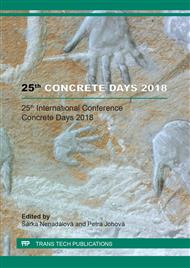[1]
L. Zhang, F. P. Glasser, Critical examination of drying damage to cement pastes, Advances in cement research, 12 (2000) 79-88.
DOI: 10.1680/adcr.2000.12.2.79
Google Scholar
[2]
A. Hoffman, Effect of redispersible powders on the properties of self-levelling compounds, Technical paper, Wacker Polymer Systems.
Google Scholar
[3]
K. Mikulica, M. Labaj, R. Hela, Rehabilitation of Floor Structures Using Foam Concrete, Procedia Engineering, 195 (2017) 108-113.
DOI: 10.1016/j.proeng.2017.04.531
Google Scholar
[4]
A. Anderberg, Moisture properties of self-levelling flooring compounds Division of Building Materials, LTH, Lund University, (2004).
Google Scholar
[5]
M. Vinkler, J. L. Vítek, Vysychání a smršťování betonu, Beton TKS, 2 (2016) 40-45 (in Czech).
Google Scholar
[6]
B. Kucharczyková, O. Karel, P. Daněk, D. Kocáb, P. Pőssl, Comparison of Measurements Methods Intended to Determination of the Shrinkage Development in Polymer Cement Mortars, Procedia Engineering, 195 (2017) 17-23.
DOI: 10.1016/j.proeng.2017.04.518
Google Scholar
[7]
E. Holt, Early age autogenous shrinkage of concrete, Technical Research Centre of Finland, Espoo, (2001).
Google Scholar
[8]
S. Ghourchian, M. Wyrzykowski, L. Baquerizo, P. Lura, Susceptibility of Portland cement and blended cement concretes to plastic shrinkage cracking, Cement and Concrete Composites, 85 (2018) 44-55.
DOI: 10.1016/j.cemconcomp.2017.10.002
Google Scholar
[9]
B. Kucharczyková, P. Daněk, D. Kocáb, P. Misák, Experimental Analysis on Shrinkage and Swelling in Ordinary Concrete, Advances in Materials Science and Engineering, Hindawi Publishing Corporation, USA, ID 3027301, (2017).
DOI: 10.1155/2017/3027301
Google Scholar
[10]
J. Liu, C. Shi, X. Ma, K. H. Khayat, J. Zhang, D. Wang, An overview on the effect of internal curing on shrinkage of high performance cement-based materials, Construction and Building Materials, 146 (2017) 702-712.
DOI: 10.1016/j.conbuildmat.2017.04.154
Google Scholar
[11]
ČSN 73 1371, Non-destructive testing of concrete – Method of ultrasonic pulse testing of concrete, ÚNMZ, Prague, 2011 (In Czech).
Google Scholar
[12]
ČSN 73 1372, Non-destructive testing of concrete – Testing of concrete by resonance method, ÚNMZ, Prague, 2012 (In Czech).
Google Scholar
[13]
ČSN EN 196-1, Methods of testing cement – Part 1: Determination of strength, ÚNMZ, Prague, 2016 (Czech version of EN 196-1).
Google Scholar
[14]
ČSN EN 13872, Method of test for hydraulic setting floor smoothing and/or levelling compounds - Determination of dimensional change, ČNI, Prague, 2004 (Czech version of EN 13872).
Google Scholar


